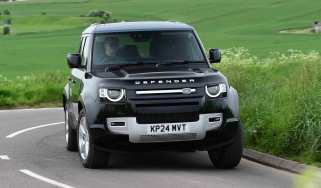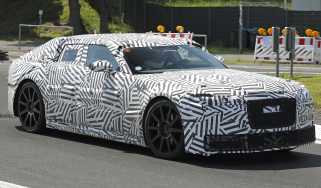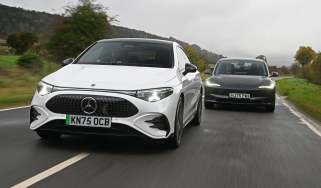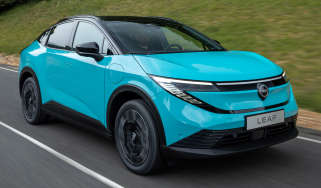Future of Jaguar, kill or cure? 5 huge challenges new CEO must meet to revive JLR
New CEO to take the reins following the cyberattack which caused a £485m loss and could wipe out whole-year profits

Hammered by global trade uncertainty, victim of a crippling cyberattack and struggling with delays to its high-risk Jaguar relaunch, JLR has suffered a terrible year. Now it’s facing a huge culture shock, as new CEO P.B. Balaji takes charge on 17 November.
Appointed by JLR’s owner, Tata of India, Balaji has served as a JLR non-executive director since 2017, but his longtime job was group chief financial officer at Tata Motors Limited. As the ultimate overseer of JLR’s financial performance, Balaji has a reputation as a quiet, tough and forensic numbers guy, who had the potential to irk members of the Indian media, former colleagues told Auto Express. Before joining Tata he spent time in finance at health, beauty and food giant Unilever.
What will the Balaji blueprint be? We talked to people within and outside the JLR ecosystem to discuss the huge challenges he faces, and tuned in to JLR's Q2 financial results call, to get a sense of the cyberattack's impact on the company and decipher what comes next.
1. Kill or cure Jaguar
How do you solve a problem like Jaguar? For more than 40 years many CEOs have tried, and failed. Balaji has taken operational control of the plan to reinvent Jaguar as a maker of all-electric luxury cars, a plan that the Tata board will have rigorously scrutinised then signed off.
Despite showing a concept car almost a year ago, production of the first new Jaguar – the four-door GT – won’t be in full swing until 2027. JLR may enjoy the breathing space – although the UK’s 17 remaining retailers of new Jaguars will not. Their number has shrunk as JLR has “wound down legacy models”, closing production lines and preparing the retailer base for lower volume backed by a more aspirational experience.

Executives will also be praying the electric transition gathers pace again: its target ‘£100,000-plus EV market’ barely exists today. Lotus’s electric relaunch hasn’t taken off, Lamborghini has turned its proposed EV into a hybrid, Bentley’s luxury urban SUV is a year away and Porsche has ripped up its ambition to sell 80 per cent EVs by 2030, adding hybrid and petrol models instead. Porsche has issued three profit warnings, and been hit by a slump in Chinese market sales.
“Selling £100k EVs is not an easy task,” says an experienced source. “The retail buyer is not buying EVs in large volume. At Jaguar’s price, you’re appealing to SME business owners or the wealthy. It’s going to be hard, and Jaguar keeps kicking the can down the road [which has] created a 12-month gap with zero production.”
Jaguar vows it will stick to its electric-only plan. “We won’t be putting a PHEV into that lovely long bonnet,” Jaguar MD Rawdon Glover told Auto Express back in February.
“I’m not thinking about 2025: a platform decision has a six-year development phase and an eight or nine-year payback phase. We need to think [about] what will happen in 2028 to 2032, and the forecast is that by 2030, EV will be the predominant powertrain.”
Engineers have created a standalone car platform, the Jaguar Electric Architecture (JEA). JLR’s argument is that this will guarantee long-range and true Jaguar dynamics, plus unlock the proportions espoused by chief creative officer Gerry McGovern – the hitmaker behind Range Rover’s premium push, the new Defender and the Evoque.
"The proportions of that vehicle are not something that could be produced off either of our two other architectures. That why it's a separate architecture: we [prioritised] the design which is fundamental to the rebirth of new Jaguar," chief financial officer Richard Molyneux told Auto Express. "It cannot look like anything else, and therefore it is not on the architecture [of] anything else."
This flies in the face of industrial logic, where scale is critical to boost margins, especially with the Range Rover’s MLA Flex aluminium architecture accommodating a 118kWh battery, big wheels and originally being the platform for an electric XJ. This was canned by short-lived CEO Thierry Bolloré in 2021, along with the J-Pace – a big Jaguar SUV – and a ‘Road Rover’, leaving JLR without any EVs following the i-Pace’s demise, and forced to buy credits from Tesla to avoid emissions fines.
Auto industry expert David Bailey, professor at Birmingham Business School, thinks it’s too late for JLR to broaden its powertrain options.
“If JEA has not been designed for [hybrid], then that’s prohibitively expensive,” he says. “JLR sounds very committed to repositioning Jaguar, but it’s a risk. We don’t know if it will work. And Jaguar is operating off a different platform to everything else. That might be because, if it fails, they want to insulate it [from Land Rover].”
JLR vows it is absolutely committed to Jaguar’s renewal, investment continues and GT prototypes are out there testing. "Richard and I have both had the pleasure to drive the new Range Rover Electric and the new electric Jaguar," outgoing CEO Adrian Mardell told journalists on the Q2 earnings call. "They are completely unrivaled in performance, in design and in capability."
Work has begun to put the new line into the Solihull factory, which will soon be capable of building the next wave of prototypes. So does Balaji put his foot to the floor – or continue the go-slow, waiting for the EV market to turn?

2. Bounce back from the cyberattack
JLR is critical to UK plc: that’s clear from how often politicians turn up there for photo opportunities, and the Government wanted to be seen to back the firm after its cyberattack.
Beginning in late August, the security breach was a cruel blow, imperilling supply-chain jobs and eliminating at least five weeks of full production across the entire manufacturing network. A JLR spokesperson said the full lost production number is not yet known and that factories hope to claw back the deficit, with some of the downtime invested in transformation work preparing for new models.
JLR posted a pre-tax loss of £485million for July to September, the period that included the bulk of the cyberattack shutdown. Finance chief Richard Molyneux said: "In q2 you've seen an exceptional charge of £196million in relation to the cyberincidents. There's also engineering cost, lost volume and many other things. Some of the volume we'll get back, some of it we will not given the state of global demand and competitor over supply."
Cyber Monitoring Centre modelling estimates the attack caused a total £1.9billion hit to the UK, largely due to lost manufacturing output, and affected more than 5,000 organisations. The financial hit won’t stop there: unexpected costs and a volume impact will also percolate through to Q3 financial performance, and JLR worries its full-year profit margin may dip to 2 per cent best case, or even zero.
One of Balaji’s priorities will be new IT infrastructure to ensure JLR is not breached again. This will take up management time and bring further disruption, as new systems are rolled out and employees get up to speed.
3. Get the minnow to boost scale – and margins
Retiring CEO Adrian Mardell boasted in 2023 that JLR had lowered the company’s breakeven point to 300,000 units; last year the company wholesaled 400,898 cars, making £1.8 billion after tax. But those figures will nosedive this year.
“If they end up doing 300,000 to 325,000 units this year, that’s sub-scale,” says our JLR-watcher. “It’s all about wholesale figures: JLR only gets paid when a car goes out the door. [Wholesale] will go down because of the cybersecurity attack, [tariffs] and Jaguar.”
In the car-making league table. JLR’s scale is tiny: BMW Group and Mercedes-Benz both shipped two million more vehicles in 2024. While JLR usually spends a healthy nine to 12 per cent of revenue on engineering and facilities, investment dipped after Covid and the semiconductor crisis – leading to a dry spell for new product.
What can Balaji do about it? It’s logical he’ll foster more collaboration across the Tata Motors family, driving down technology and purchasing costs. JLR’s other pure electric car platform – EMA – will underpin Tata’s premium ‘Avinya’ EV brand for the Middle East, Asia and Africa. Further hardware sharing looks difficult given the divergence between JLR’s premium customers and Tata’s lower-cost markets, although more software collaboration makes sense.
JLR currently buys in V8s from BMW, but the timing looks impossible to strike a wide-ranging alliance with another western car maker. “All the world’s OEMs are struggling for profitability: it’s difficult to see where a consolidation or massive collaboration [comes from],” says our source. “They’re not going to make money out of Jaguar, so they’ve got to make it out of Land Rover.”
That means a focus on selling more top-end Range Rover special editions and high-performance Defender Octas. “We’re going to see more in the way of financial discipline, with a big emphasis on margin recovery,” says Professor Bailey. And that will mean a laser focus on cost-cutting – reportedly a Balaji speciality.

4. Producing the right cars – at a faster pace
Incredibly, JLR hasn’t launched an all-new model since the Range Rover Sport in 2022. With Chinese car brands supercharging development times, and Renault siring the new Twingo in two years, Land Rover’s stable of the seven-to-eight-year-old Velar, Discovery and Evoque looks horrendously stale.
“Adrian Mardell didn’t launch a product and JLR is light on electric, so they’re at risk of fines and buying credits,” says our commentator.
This pressure should alleviate in 2027 as JLR’s EVs hit the market; the Range Rover Electric arrives next year but that’s two years later than the outgoing CEO promised. “The car will come to market when we’re ready with the perfect car, after one of the biggest test and development programmes for a single propulsion system in our history,” chief programme engineer Simon Fairbrother says. JLR is aware of the cost of warranty claims, and determined to chase an EV benchmark, essential to harvest the maximum number of prospects on the 60,000-plus waiting list.
A second electric Range Rover, similar in size to the Velar and built at the Halewood plant on Merseyside, is also due to start production in 2026. Its sister model, a downsized electric Defender on the EMA architecture, will follow. But there are no obvious plans to bolster the petrol and hybrid line-up, leaving JLR dependent on the electric market where margins are under pressure due to high battery costs and incentives.
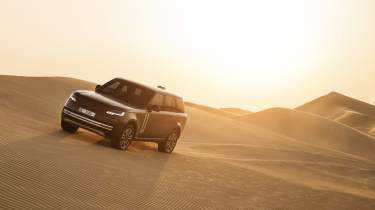
5. Overcome sluggish economies and market headwinds
Ruptures in the two biggest markets – China and North America – have badly hit the car industry, and JLR is no exception. Chinese sales of Range Rovers and Range Rover Sports have been a critical source of profits for years, but consumers are turning to domestic brands which are beginning to offer credible luxury competitors. And changing market dynamics pose a further threat.
"China is definitely a concern," says CFO Richard Molyneux. "There are multiple aspects to it, including a change in the luxury tax imposed [in] July, which took the threshold for luxury tax down...[and] encapsulated an awful lot of our Range Rovers. It is impacting sales...[and] it's definitely a step change down over where it was a couple of years ago for both us and others."
JLR pivoted to embrace the North American market, but President Donald Trump introduced import tariffs finalised at 10 per cent on UK-built cars and 15 per cent on the EU-assembled Defender. The financial impact during the first six months of the year is clear, explains Molyneux: "Half-year losses were £134 million, and include the impact of incremental US tariffs on our exports from the UK and EU."
The Middle East and North American markets are stable, but "Europe is probably a little bit vulnerable. The economy is not in the best shape there. The UK, certainly up until now, is stable...There's no region at the moment that's shooting the lights out," concludes the CFO.
That is the context into which Balaji arrives, with JLR up against it. And failure is not an option.
“JLR is still so important to the country: supporting 200,000 jobs and suppliers,” says our source. “They have got to get it right. P.B. Balaji has got to get it right.”
Get even more from Auto Express, follow our channels...
• Google
• Reddit
• Whatsapp
Find a car with the experts


